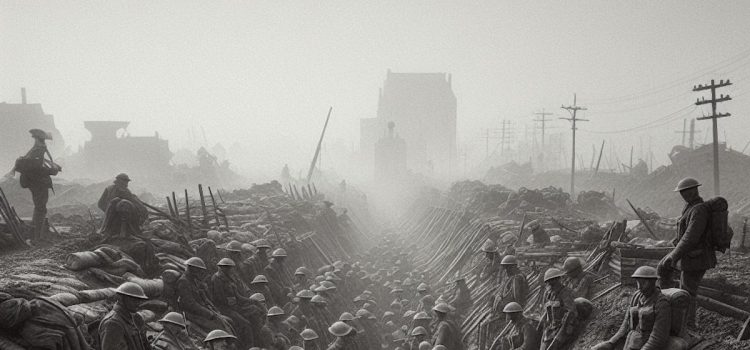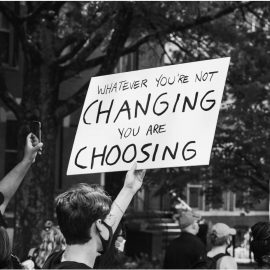
Why did the United States enter World War I and World War II? Who benefited?
In A People’s History of the United States, historian Howard Zinn discusses World War I and World War II in the chapters “War Is the Health of the State” and “A People’s War?” The wars represented some of the first times the new American empire acted on a global stage.
Keep reading to learn about American participation in each war and the popular response to them.
World War I (1914-1918)
In the chapter “War Is the Health of the State,” Zinn describes World War I as a years-long bloody and pointless conflict between European imperial powers. He argues the US joined the war in 1917 to protect American elite financial interests despite mixed or even anti-war public opinion. Before and early on in the war, American elites developed strong business ties with and made large investments in Allied nations. Going to war allowed them to protect these investments.
Elites tried to garner support for the war through propaganda campaigns and suppressing dissent. For example, the Espionage Act of 1917 made criticizing the war essentially illegal, and it was used to arrest a number of high profile critics of the conflict. Despite these efforts, public opinion was by no means pro-war: When the US government asked for one million volunteers at the start of the war, only 73,000 people signed up in the first six weeks. The government had to start drafting people to meet their quota. In addition, the Socialist Party—the main anti-war party—made significant gains in state and local elections during the war.
(Shortform note: For decades after the end of the war, the public and historians alike generally accepted that the US entered the war because of elite economic interests. This was connected to general public regret around entering the war, as people felt the US had only joined to benefit a few select elites. However, views on the war began to shift in the decades following WWII, when historians started arguing the US went to war to preserve democracy or protect national security. Some scholars suggest this shift in perspective was tied to overall political changes in the US, as the public and academia became less focused on questions of class conflict and economic interests in the latter half of the 20th century.)
World War II (1939-1945)
Zinn discusses World War II in the chapter “A People’s War?” In 1939, the war began between the Axis Powers, led by Nazi Germany, fascist Italy, and Imperial Japan, and the Allies, led by the UK, France, and the USSR. The US joined the Allies two years later. However, Zinn argues that American participation in the war was less about fighting fascism and more about protecting imperial power and elite financial interests. He offers several pieces of evidence: First, the US didn’t fight fascism in the years leading up to the war, whether in the Spanish Civil War or during the gradual rise of Nazi Germany. Second, the US didn’t join the war until its imperial possessions were directly attacked.
(Shortform note: Some US elites weren’t just disinterested in fighting fascism, but actually plotted their own fascist coup in 1933 known as the Business Plot. A number of elite bankers and businessmen believed FDR was going to transform the US into a socialist state, and they wanted to replace him—and the US democratic system—with a fascist dictatorship. They planned for Marine Corps Officer Smedley Butler to form a fascist veteran’s association and plan a massive march of disgruntled veterans who would depose the president. This strategy was similar to those used by fascists in Germany and Italy in previous years.)
Regardless of this elite reasoning, popular opinion in the US was mostly pro-war. Many Americans supported the allied cause due to patriotism and anti-Japanese racism. While some Black Americans didn’t want to fight for their oppressors, many others were drafted or voluntarily joined the prejudicial and racially segregated US military. Despite the overall pro-war sentiment, though, the US government still suppressed any perceived dissent—using the Espionage Act to arrest anti-war activists and imprisoning thousands of Japanese Americans in internment camps, even if they supported the American war effort or had no connections to Imperial Japan.
(Shortform note: American anti-war sentiment looked very different in WWII than it did in WWI. Opposition to WWI was mainly rooted in socialist, communist, pacifist, and anti-imperialist groups who believed the war was a pointless waste of life. While some of these groups opposed WWII as well, a significant portion of the anti-war movement during this period had fascist or antisemitic tendencies instead. These groups weren’t opposed to imperialism or war in general, but instead wanted to keep the US from fighting against the Axis powers. Examples of fascist or antisemitic anti-war advocates included American businessman Henry Ford, aviator Charles Lindbergh, and the pro-Nazi German American Bund.)
Post-War Settlement
As the major power who’d suffered the least damage during the war, American elites were able to dictate a favorable post-war political and economic landscape, explains Zinn. They did so in a number of ways: funding massive reconstruction programs in Western Europe through the Marshall Plan, granting the US a significant amount of control over the newly formed United Nations and International Monetary Fund, and securing oil for decades to come through an alliance with the Saudi royal family.
Because of this uncontested economic position, enough money was flowing into the country that elites were willing to provide benefits to many American workers and laborers. The GI Bill provided funding to help thousands of veterans buy homes and attend college. Infrastructure projects, anti-poverty initiatives, and cheap goods caused overall standards of living to rise. At the same time, however, military, business, and political elites collaborated to ensure the existing war economy would continue indefinitely, concentrating disproportionate wealth in their hands.
(Shortform note: Mills (The Power Elite) argues that the post-war years also saw US elites coordinating their efforts and interests more than ever before. He explains that to supply and fight the war efficiently, the US military, civilian government, and private corporations had to directly cooperate. But after the war ended, this high level of cooperation and integration continued. Mills suggests that while elites from these different spheres may have had broadly similar interests before the war, it was during and after WWII that they started truly acting as one coherent power bloc.)






